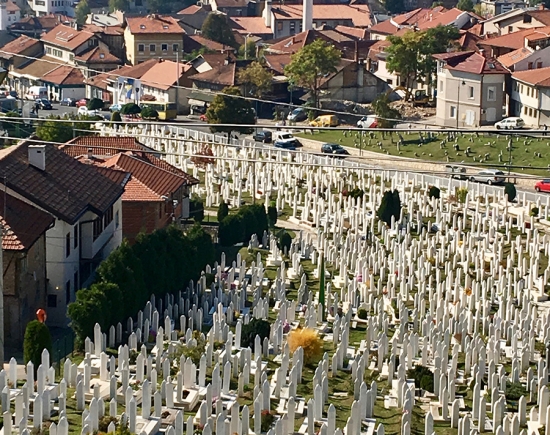Arriving in Bosnia
We arrived in Bosnia on an October evening and were greeted by our guide Resad Trbonja. Resad grew up in Sarajevo before the wars and in a time when Bosnian Muslims, Bosnian Serbs and Croats lived side by side. His best friend at school was a Serb. You can listen to an interview with Resad talking to me about his experiences of growing up in the former Yugoslavia under Tito and his experiences during the war from his perspective as a Bosnian Muslim.
A beautiful fusion of Ottoman and European
The first thing that struck me about the region was how beautiful it was. Sarajevo is a living example of east meets west. Along the streets of the town, mosques, synagogues, Catholic and Orthodox churches sit side by side and there is a real fusion between Ottoman and European architecture.
The ethno-nationalistic divisions in Bosnia Herzegovina date back centuries to the time of the Ottomans whose rule brought Islam to the area. Yet it seemed to me that still there is a pervading idea of a motherland, whatever your affiliations.
“Growing up, the only difference between us was in our names,” said Resad, our guide. I wondered how far this was true of the former Yugoslavia. While centuries-old cultural and religious differences pervade, in reality they were one people. They spoke the same language and looked the same.
In the 1970s and 80s, Sarajevo was around 50% Muslim. Today, after the events of the 1990s the population of Sarajevo is mainly Muslim, with many Serbs and Croats having left the city.

One of the many graveyards prominent in the city, many of which contain the graves of victims of the siege of Sarajevo
Republika Srpska and Srebrenica
A couple of hours away from Sarajevo you find yourself in Republika Srpska, an autonomous area of territory within Bosnia but with close ties to Serbia and where the majority of inhabitants are Bosnian Serbs.
Immediately as you enter Republika Srpska you notice changes and road signs adopt the favoured Cyrillic alphabet of the Serb people as opposed to the Latin used elsewhere in Bosnia Herzegovina. The River Drina separates the autonomous Republika Srpska from the rest of Bosnia Herzegovina.
It is in Republika Srpska that you find Srebrenica, an area of land fought over fiercely in the conflict and now infamous for the events that took place there in July 1995. In Srebrenica, over 8000 Bosnian Muslim men and boys died. The International Criminal Tribunal for the former Yugoslavia (ICTY) has defined this as a genocide, although despite this international legal position and in the face of evidence of the deaths, there are those who disagree with this term and others who deny that it happened at all.


